Cory Huff's Blog: The Abundant Artist Goodreads blog, page 23
January 3, 2018
Making it as an Artist in the Algarve
Alyson Sheldrake is a creative and successful artist living and working in the Algarve, Portugal, with her photographer husband Dave. Her paintings are in private homes across the world; her last solo exhibition was an almost sell-out success; and she has a steady stream of commissions that keep her ticking over.
Her paintings might not sell for thousands of euros – most sell for between 250-500€ – but they sell well – and often. She has never exhibited in an art gallery, preferring to set up and run her own ‘Pop-Up’ gallery events; and she is also not afraid to be creative in other areas of work too, having recently set up an Algarve Society of Artists, an associated website and online quarterly free Algarve Art! magazine. She tells us her story here:
Six years ago, I gave up a successful – yet exhausting – career in education in the UK. I was working 70+ hours a week as a Director of Education, that left me little time to do anything else each evening but eat a hurried meal, clean my teeth and crawl into bed each night waiting for the alarm clock to ring the next morning.
But my dream of being a full-time artist and having my own studio space was always there inside me, tucked away – but there, insistent in its quiet roar of longing. My husband’s retirement from the Police gave us the chance to chase the ultimate dream – to pack up, sell up and move to live in the Algarve Portugal and both start new careers and lives. I was aged 42 and I was finally off! I did take a big gulp when I handed in my notice from what was essentially the ‘dream job’. Have I regretted it? Not a bit!!
And that is my first big advice to you – Be brave! Go for it! If you wait for someone to hand you a creative break – you are going to die with those paints and brushes still sat in a drawer. No-one will stop you – or help you – with this one. If you want to create – or sculpt – or paint – then just do it! Make time – make space – make a step forward … even a small one – or a giant one if you can! Not everyone can give up their job and move to a new country, but you have to go for it if the creative bug is ticking away inside you.
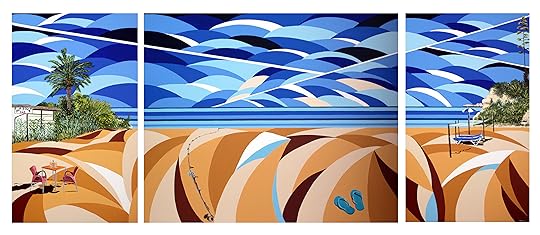
I gave up a secure career – and a big salary – to leap into the Algarve sunshine and the unknown. I woke up the first morning in our new home with a plan – to spend the next eight months just painting. I had always dabbled, done the odd course, bought lots of paints and never had the time to use them. Now I had time – lots of time – days and months stretching ahead of me – and my very own ‘space’ to work. So I just dived straight in, picked up my brushes and went for it.
That was actually the easy part. I had waited so long to be able to do this ‘for real’ that I went wild and painted virtually every day. If I wasn’t actually painting I was out photographing ideas for paintings, writing down notes and sketching, prepping and sanding boards and priming them ready to paint.
And then suddenly I had 32 paintings all finished. And a style of my own that came out of that painting frenzy. Bright bold waves of colour that surround a realistically painted focal point; no doubt inspired by the warm sunshine and bright blue skies and seas of the Algarve.
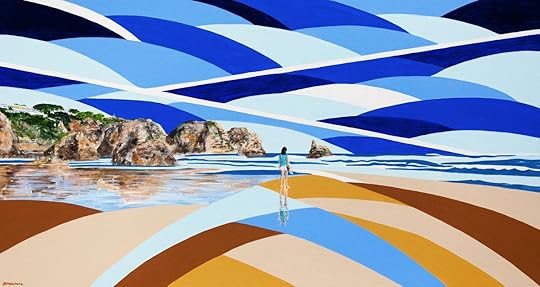
‘Girl on the Beach’ © Alyson Sheldrake
My husband had been equally busy, his project was to take one photo every day and post it up on his Facebook Page under the title ‘Algarve 365’
We inched our way through discovering how to use Social Media back then, in the days when a good photo could hit 46,000 Likes in one day – yes that happened to us! We quickly built up a good genuine following of ‘real’ people that seemed to like what we were both doing.
I also knew that we needed a good internet presence and spent hours and hours learning how to build a website for each of us. Trial – and much error! But we have both had websites for several years now, the stats are good on them, and I sell my art work directly through my site using Paypal. And yes – I do make sales – and post worldwide. But much more than that, my website www.artbyalysonsheldrake.com is a showcase for my work, it ‘professionalises’ what I do, and it is a great way for people to connect with me and my work and to share it with their friends. My website and Facebook have been brilliant for making connections that have been invaluable to us.
Traditional Gallery ? No thanks!
Right from the start I knew that I didn’t want to take the traditional gallery route with my work. 50% commission is standard out here, and we have heard rumours of 70% commission rates – or even worse – the ‘vanity gallery’ route – “you pay me lots of money to display your work on the wall, and if you are lucky, well I might be able to sell it for you.” Erm .. no thanks!
My view has always been that I know my work better than anyone else, and people seem to really like being able to say that they ‘met the artist that painted that’ when they show off a painting in their home. With a background that included organising and running conferences for over 100 Headteachers; the thought of setting up a gallery event of our own hardly seemed daunting. Although I quickly realised that not having a PA and admin team to support me was something that I did miss! The big problem was where could we hold an event?
Social media came to the rescue! We posted up our ideas on my Facebook page and within half-an-hour one of our followers – head of marketing at one of the biggest and best hotels on the Algarve no less – had contacted me and said that they wanted to host a ‘Pop-Up’ event in their hotel and could they meet with us.
We met them – they were great – the space was fab, the timing was excellent – there was only one small snag. It is a hotel – with a posh conference space – and we were told that “you cannot put anything up on the walls”.
“No problem” we replied (!) and the deal was in place. At no cost to us we had a fab place to run an exhibition – and here is my second piece of advice: Follow your gut instinct! It doesn’t let you down – sometimes you just have to say “yes” and figure out the details later!
Run an art exhibition -showing paintings and framed photographic prints – with no wall space available to us. No problem! We went away, husband scratched his head in a local DIY store, and we bought 18 ‘cavaletes’. They are the wooden A-frame structures you buy to balance a table top or board on at each end. We backed each side with white melamine coated board – stood them on tables and voilá we had the perfect – and portable – display system for our work. For very little cost. We are still using them today – over six years – and more than 12 Pop-Up exhibitions later.
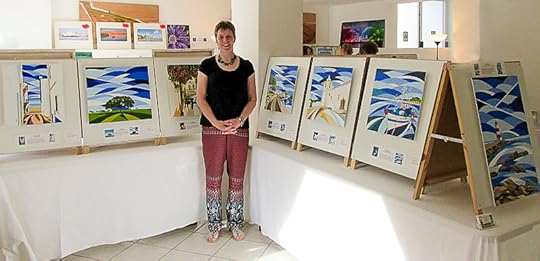
And we have never looked back! Within an hour of our first opening we had sold 4 photo prints and 2 original paintings. At my last solo event I sold 20 of the 24 paintings I had for sale. We have refined and amended the process of course along the way, and at each event we have added new ideas and got better at what we do.
My two best pieces of advice are start a mailing list and treasure it – and don’t skimp on your advertising and promotional materials.
At every event I run a Free Prize Draw – usually to win a small painting, limited edition print or even a photo shoot with the photographer husband. We always make it something worth winning. Then make sure that there is a ‘would like to keep in touch with you’ tick box on the form. That – and a ‘Join now’ on the front page of my website – has resulted in almost 500 loyal subscribers to our mailing list. And we look after them – every month – on the first of the month we send out a free e-mail newsletter. It started out small, and now it is 10-12 A4 pages send out via Mailchimp and set up as a free online mini-magazine format designed through publitas.com (a great free programme)
You can click here to see an example:
http://artbyalysonsheldrake.com/Newsletters.html
The feedback we get is very positive, people really seem to look forward to receiving our newsletter each month and enjoy reading it. We share our work of course, special offers, work in progress, client feedback, upcoming events and information. We also promote and share other artists, photographers, websites and products that we can genuinely recommend and like too. Our retention rate for subscribers is amazing, our ‘open rate’ sits well above 65% every month, and results in repeat customers, commissions and new clients on a regular basis. You have to put the work in at the computer – but it is worth it.
We have also worked hard to build good credible relationships with our local media – both newspapers and magazines. I am always amused to recall a conversation with a local artist who asked me incredulously “how come you are always featured in the local newspaper whenever you have an event?” .. Seriously?!? Well we send them a press release and they publish it. Her reply “Oh I didn’t know that you could do that” !!
The press need good copy and nice bright images – and we have those in abundance as artists. Often we will send over photos of events for them to use free of charge (with a credit of course!) and the resulting links we have forged are both strong and genuine. We try to act professionally and make their lives easier, and it works both ways; they are then genuinely happy to share our events and news items with their readers.
The Artist as a Professional Career Choice
And that is the trick really, you have to see yourself as a business – as well as a creative artist. If you don’t take the traditional gallery route – then you have to be your own publicist and promoter. No-one else will do it for you! Sure, friends will share things for you on Facebook – as long as you give them something worth sharing. But then those people have to have somewhere to ‘land’. You have to create the attractive tree full of fruit to entice the birds to come and perch on your branches. And then you have to encourage them to nest there too! Because if you don’t – they will fly off and perch themselves on someone else’s tree!
The hardest part of all was actually a simple thing – to take the step of calling myself an ‘Artist’ (note the capital letter A!). When someone asks you “what do you do?” (and they will!) you have to be brave enough to reply “I am an artist” – not “oh I paint” or “I dabble in art”. Actually give yourself the job title of ‘Artist’. Funnily enough, when I started to do this, everything else fell into place too.
So spend some money – get a website – make it yourself if you can if you want to save some money; there are plenty of good sites out there that give you basic templates and ‘what you see is what you get’ layouts to play with. Buy the business cards – design them well – and get them professionally printed. You would be amazed at how many artists I meet that don’t have a business card – or they write their e-mail address on a scrappy piece of paper. Those scraps always end up getting lost or land in the bin … if they even make it home .. that’s what happens to scraps of paper (you do know that right?!?)
And then when you have that shiny new business card full of examples of your colourful art work .. carry them with you wherever you go – and give them out!! – to everyone that you can! You might be surprised to find out how many people are interested in what you do – so share it with them. My cards always have a small range of my art work displayed on them – it’s a teaser to encourage people to visit my website. “And oh – did I mention that I have a monthly newsletter too?” Oh yes – you can be bold – and polite – but brave! What is the worst they can do? – say no thanks! (Trust me – they don’t!)
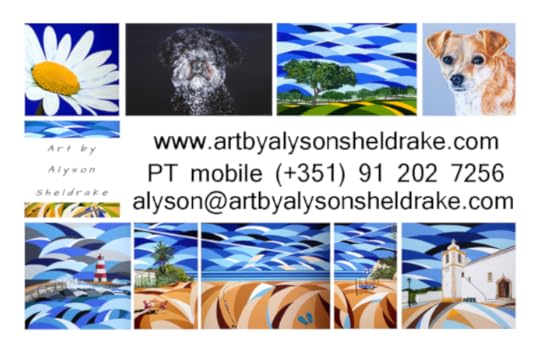
Creating a Society of Artists
My final piece of advice is this – you know those 4am moments when you wake up and have a great idea? (tell me it is not just me that has those!?!) Well write them down – and when you wake up again before 7am (I have a dog – we walk the beach in the quiet dawn every morning!) – if the 4am idea still seems like a good one – then go for it!
I spent months with some small but exciting ideas whirling round in my head .. those ‘I’d love to do that’ ..and the ‘Why isn’t there a {insert your own idea here} already?’ – thoughts that persist in popping up in your mind in the middle of the night … sometimes being a creative person can be an exhausting – as well as exhilarating – experience!
The Algarve didn’t have any form of Society set up for artists – a group to support and encourage – and promote art and artists in the region. Something to wave an artistic flag and bring people together. So that was one of my ideas to set up such a group.
Then I met a bunch of artists over a period of time, none of whom had their own website – or even a business card! or any social media presence at all. So another 4am idea was ‘what if I set up a website for art in the Algarve, every artist can have their own listing on the site giving them a URL and we can all share it across social media and other platforms and try to increase their exposure for their work?’. The idea of creating a Directory of art and artists for the Algarve was born.
Then another 4am idea brought together lots of smaller ideas I had been incubating for a while. I have long wanted to expand our little monthly newsletter into a proper magazine which could showcase art and artists – promote events and exhibitions before they happened (the Algarve is famous for promoting things after they have happened!) and also to be an interesting and informative resource for art lovers to read and share online. So the idea of a quarterly free online Algarve Art! magazine was developed.
It might sound like a lot of extra work – and it is – but this summer I decided to just go for it! I brought all of my ideas together and launched the Algarve Society of Artists. I had no idea how it would be received, although testing it out with some trusted art friends I knew I had a good idea in the making. Well – it has been a crazy three months! We already have over 80 members – a website www.algarve-art.com and a quarterly online magazine that had over 57,000 page views in the first 3 weeks of publishing Edition 1 in October. The second edition is due out in time for Christmas.
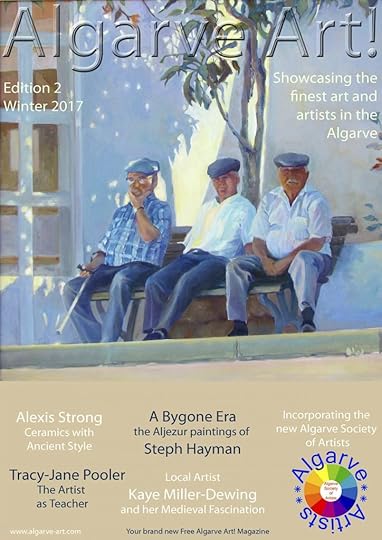
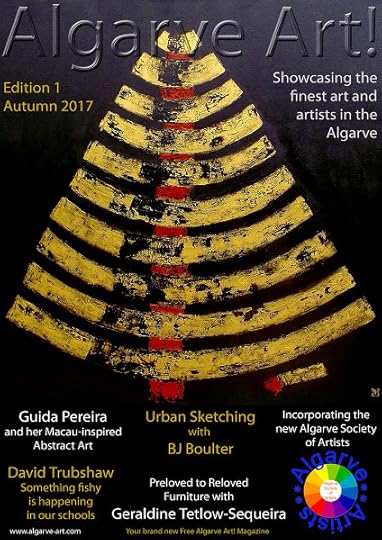
The new Algarve Art! Magazine was launched on the 5th October – with Edition 1 – Autumn 2017. You can click the link here to read this free online:
http://en.calameo.com/read/005290311cfc89830c3e2
The spin-offs to all of this have been amazingly positive and exciting too. Suddenly I am getting phone calls from all sorts of interesting people – I am starting to be a ‘go-to’ person for art in the Algarve which is obviously great for me as an artist too. I have helped one of our members, an art tutor, to find accommodation to run a new art class from. I have helped some of our members to find excellent corporate sponsorship and funding for a local art project, and I am in talks with a local art tour company that want to link up with local artists and galleries.
We now have a dedicated 2 page spread each month in a local magazine showcasing one of our members each month in a new ‘meet the artist’ feature; and I am always busy negotiating discounts and special offers for our members. We have our second ‘members lunch’ and get-together planned in time for Christmas, and plans for running our own ‘Pop-Up’ events and exhibitions in the future.
All that in the first three months!
So if there isn’t the opportunity for you to ‘put yourself on the map’ locally as an artist already – have a look around – be creative – maybe you need to draw out the map yourself first!
And don’t be afraid to steer a different path to everyone else. Social media and the internet has opened up a whole new world of marketing opportunities for artists. No longer do we have to drop off our precious paintings to a shop or gallery and then sit back and wait for them to let us know they have sold one of our paintings – taken their 50% commission – and have an envelope with some money in waiting for us to collect next time we are passing. We can be fantastically involved in our own promotion and marketing, we can build our own loyal following, and enjoy being creative, original and supportive to other artists in so many different ways. The path of the ‘artist’ does not have to be a long and lonely one anymore!
~ ~ ~
Alyson works as a full-time artist in her studio in the Algarve. Her work is for sale, she is always interested in new commissions and work; and if she is not busy painting or working at her computer; you can find her walking her rescue Spanish Water Dog on a local beach.
http://artbyalysonsheldrake.com/
The post Making it as an Artist in the Algarve appeared first on Online Marketing for Artists.
January 1, 2018
Managing a Successful Print Studio with Patricia Vargas
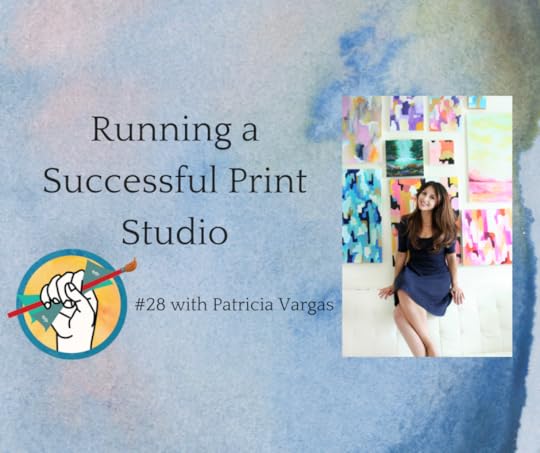
In this episode we cover:
1:25- How Patricia began selling prints on Etsy
5:15- Selling digital prints comes with its own unique challenges
9:00- How Patricia came to realize that she could make a living from her art
13:20- The advantages and disadvantages of selling on Etsy
20:50- How to get website traffic from Pinterest
24:40- Finding success selling prints on Society6
29:30- How Patricia’s licensing deal with Anthropologie came about
31:05- Finding the balance between living life and 24/7 hustle to build your business
36:05- Helpful productivity and time-management tools that Patricia recommends
Download the transcript here:
Running a Successful Print Studio with Patricia Vargas
Resources:
The 4-Hour Work Week by Tim Ferris
The post Managing a Successful Print Studio with Patricia Vargas appeared first on Online Marketing for Artists.
December 20, 2017
Should You Use Patreon or Take Payments on Your Own Site?
The primary purpose of the recurring payment platform is to enable a creator to build a base of patrons who will support them on an ongoing basis. The model of subscription-based crowdfunding has been a game-changer for creatives. But it doesn’t come without caveats.
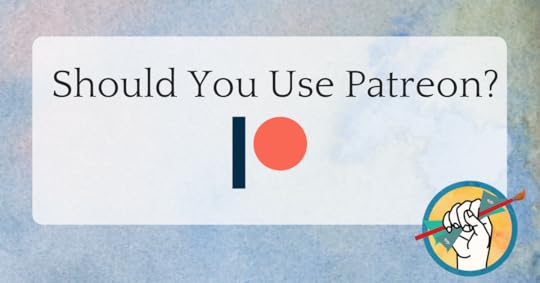
First, the pros:
Consistent and reliable payments every month. (Reliable as in you’ll get your money on time, not as in the platform won’t ever make changes to their fee structure that cause contributors to pull out en masse… see below.)
Patreon and other similar platforms will take care of chargebacks and declined payments to protect the creator.
They allow the creator a pretty well built-out profile, which functions as the hub of activity and interaction between creator and contributor. Community pages on Patreon are cool and allow contributors direct access to the creator to ask questions and give feedback.
Now the Cons:
You pay a percentage of your income to Patreon- 5% directly to Patreon, and another 5% or so in processing fees.
Here’s the big one: the risk when you depend on a 3rd party platform for your entire livelihood is that you are at their mercy. This was a risk felt sharply by the YouTube community when it began mass demonetization of videos to appease advertisers, an example that illustrates perfectly why it’s incredibly risky as a creator to depend entirely upon a 3rd party platform for your income.
If the platform changes their fee structure, as Patreon recently attempted to do, you may find yourself losing patrons at an alarming rate. Patreon recently announced a change to their fee structure that charged contributors a fee for every separate subscription they maintained on the site. This meant that patrons with a high number of small monthly payments to creators would be charged a monthly fee for each individual subscription. There was a massive public outcry and Patreon rescinded the change, but not before many angry patrons withdrew at a significant cost to creators who depend upon a high number of low payments for their livelihood.
Why Not Do It Yourself?
Patreon is a well-known giant and pioneer of the subscription-based crowdfunding movement, but that doesn’t mean that it’s your only option. Using a third-party such a Patreon to manage your subscribers may take some of the guesswork out of setting up payment plans as well as providing some cool features, but it comes at the cost of not truly being in charge. Just ask the hundreds of creators who lost subscribers on Patreon.
Meanwhile, with some planning and up-front work you could set up your own website to accept recurring payments, and reap the same benefits as joining Patreon with added independence from extra fees and policies made to benefit the company rather than the creator. There are many payment portals that allow easy set up of recurring payments, including Stripe, Square, and Paypal, all of which integrate easily with popular website platforms like SquareSpace and WordPress.
Why aren’t more artists doing this? It likely comes down to the visibility and convenience of platforms like Patreon, and a feeling of intimidation at setting up your own system. But you don’t have to know how to code to do it. If you can set up a good website for your art business, you can set yourself up to receive recurring payments.
Do you use Patreon or another subscription-based crowdfunding platform for your art business? Have you considered making the switch to taking payments directly on your own website? If not, what’s stopping you?
The post Should You Use Patreon or Take Payments on Your Own Site? appeared first on Online Marketing for Artists.
December 18, 2017
Finding Success in Crowdfunding and Conventions with Stephanie Law
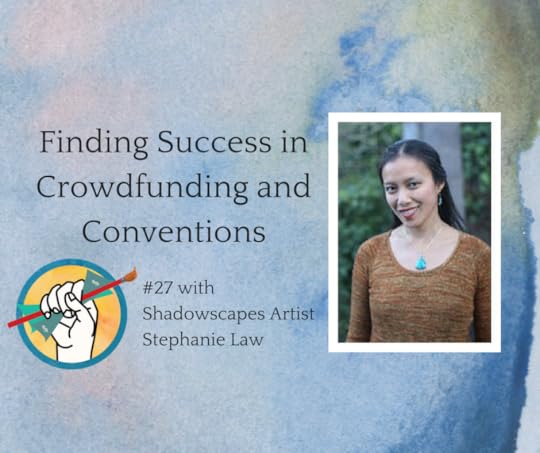
In this episode we cover:
5:10-How Stephanie is inspired by the mythologies and fairytales that stem from oral tradition and span thematically across cultures and languages
13:38-Stephanie’s struggle to convince college advisors of the validity of pursuing both computer programming and art, at a time before digital art had entered the scene
25:40-The complexity of “Kickstarter math” and the importance of having your numbers right before committing to a crowdfunding campaign
40:46-Stephanie used to exhibit at 12-15 conventions a year. She shares how helpful those conventions were in growing her business, and where she’s at now
45:15-How early-career artists can have a profitable experience on the convention circuit
49:12-You can be successful at conventions even if you’re an introvert!
53:40-Stephanie’s recommended reading for those interested in fairy tales and ghost stories
Download the Transcript Here:
Conversation With Stephanie Law
Resources:
Strange Stories from a Chinese Studio, translated from Laio Chai stories by Pu Sung-ling
Stephanie’s website: www.shadowscapes.com
Stephanie’s Patreon: www.patreon.com/StephanieLaw
Stephanie’s Youtube: https://www.youtube.com/user/puimunlaw/videos
Stephanie’s FB page: https://www.facebook.com/Shadowscapes/
Stephanie’s Instagram page: https://www.instagram.com/spmlaw/
Stephanie’s Twitter: https://twitter.com/shadowscapes
The post Finding Success in Crowdfunding and Conventions with Stephanie Law appeared first on Online Marketing for Artists.
December 14, 2017
How to Recognize the Signs of an Art Scam
Unfortunately for the thousands of hard-working artists hustling to make an income from their work, the art world is rife with scams. The good news is that the most prevalent scammers follow one of a few particular scripts or formulas, which you can easily protect yourself from once you learn how to recognize the signs.
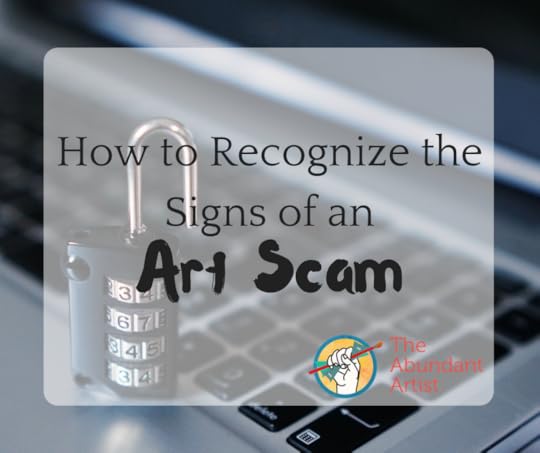
Red Flag #1: Non-Traditional Forms of Payment
One of the most common forms of scam is the cashier’s check/money order overpayment scam. Hundreds of variants exist and are easy to find with a quick Google search. Essentially, the scammer will express interest in a piece of your art, and then offer to pay for it with a money order or cashier’s check. The really good ones will provide you with a convincing excuse for why they can’t pay with a more traditional method at the moment (i.e. I’m currently out of the country for work, I’m currently moving to a different country, I’m on a boat in international waters). They’ll then ask you send a chunk of that money on to a 3rd party (see below) such as their personal “shipping agent”. You’ll then get notified that the money sent to you was in fact stolen funds… and you’re now responsible for all of it.
In 2017 there are very few reasons why a legitimate collector cannot pay over the internet with a conventional credit card or with Paypal. If they seem to be legitimate but insist on using a non-traditional payment form, you can always offer to use an escrow service for everyone’s peace of mind.
The easiest way to avoid this one is to perform all transactions through a shopping cart interface on your website. If someone emails you asking to purchase a piece, kindly direct them to your online shop.
Red Flag #2: Asking You to Send Some Money to a 3rd Party
In conjunction with the offer to pay via cashier’s check or money order, a scammer will ask you to deposit the entirety of the check and then use a portion to pay their 3rd party shipping agent directly. Do not do this.
An easy way to avoid any confusion or potential for scamming is to state your shipping policies very clearly on your website. For example, you always ship via FedEx Ground, and the shipping cost is already clearly stated on the piece in question.
Red Flag #3: Suspicious Phrasing
Many email scams will read strangely, with odd and generic phrasing. Punctuation may show up in strange places. The email may open with a conversational apology for not replying to a fictional email from you like “Hi there, sorry for not getting back to you sooner. I am very interested in the piece.” It’s intriguing- perhaps you had an exchange with a potential collector a while back and forgot about it?- and so you open the email.
The phrasing will often be very vague and generalized, i.e. “I think your artworks are very amazing.” This is a pretty good indicator that they haven’t even seen your work and are not actually interested in it.
Scammers will sometimes ask you to send them images of your work and then tell them a price. This is all information that should be displayed clearly on your website, so the solution is simply to direct them to your online shop or gallery.
Red Flag #4: Asking for Personal Information
Goes without saying, always bears repeating. A request for personal information is always, always a giant red flag. Do not give away social security numbers, bank account information, or your personal address. It can be tempting to jump through whatever hoops requested of you in order to get a sale, especially if it’s an expensive piece. But once again- this is 2017. It is very, very easy to execute a secure transaction online without you ever having to provide your personal information to a potential collector.
What Can You Do About It?
Your best defense against scams is to use a solid shopping cart interface for all Internet transactions, refuse to accept non-traditional payment methods, and never, ever give away personal information on the Internet. Being scammed or even an unsuccessful attempt can feel incredibly frustrating and insulting, and it’s normal to want to somehow “get back” at the scammer. Some people satisfy this urge by engaging with the scammer in order to “waste their time”, but honestly this is just a waste of your own valuable time. Your best response is to ignore it and move on, or possibly submit a complaint to the FTC using the link below.
Resources
Stop Art Scams– a blog by artist Kathleen McMahon that catalogues common art scams.
FTC Complaint Assistant– submit a scam complaint to the FTC.
Better Business Bureau– tips on avoiding art scams
Do you find yourself a frequent recipient of art scam attempts? Do you notice common tactics? Please share your experiences in the comments.
The post How to Recognize the Signs of an Art Scam appeared first on Online Marketing for Artists.
December 11, 2017
Conversation with Justin from Artwork Archive
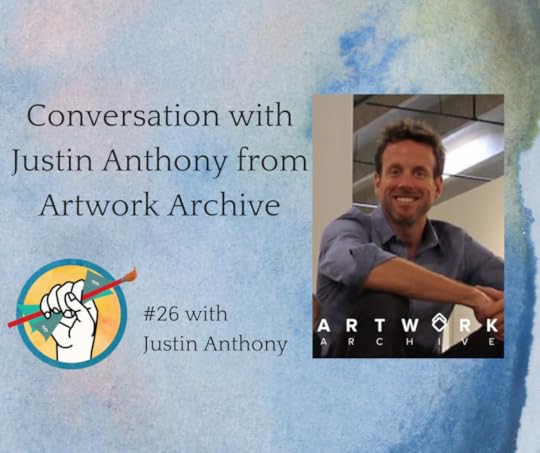
In this episode, we cover:
1:43- How Artwork Archive got started
6:44- Artwork Archive’s philosophy and process of providing valuable content to their audience
11:07- One of the big keys to good content creation is know thy audience
16:35- What it’s like to run a business that serves artists
27:20- How the Artwork Archive discovery engine began and what it’s for
31:45- How Artwork Archive plans to implement AI in their artwork discovery tools in the future
34:16- Some of the industry-level problems with the current technology available to help people discover new art
39:40- How Artwork Archive is helping artist grow their careers
Download the transcript here:
Justin Anthony from The Artwork Archive
Links
Artwork Archive discount for TAA readers
The post Conversation with Justin from Artwork Archive appeared first on Online Marketing for Artists.
December 7, 2017
The Art of Fine Art Printing
I would like to introduce you to Eric Joseph, who taught me how to produce exquisite archival fine art inkjet prints of my watercolors with beautiful, accurate color. My printing process has catapulted from torturous to joyful!
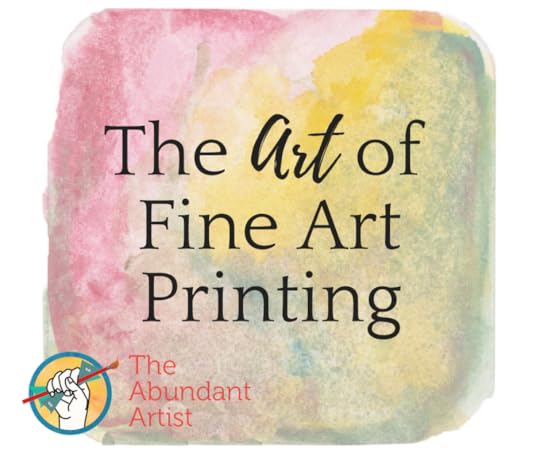
Advances in technology have made it seemingly easy for artists to produce beautiful archival inkjet prints of their work. For some artists, with bold styles, the process is relatively simple and straightforward. But, watercolors are notoriously difficult to reproduce, especially mine, which are exceptionally delicate and detailed.
I’ve had a love/hate relationship with printing for over a decade. I caught the digital printing wave early. In 2002, Epson unveiled their revolutionary printer, the Stylus Photo Printer 2200. I purchased one and bought into the dream of selling fine art prints of my art. That is… if I could only make a decent print!
I wasted a lot of expensive ink, paper and time trying. The only consultant I knew charged $2,500 a day, so I was stuck trying to figure things out for myself. Eventually, I got to the point in which the mere act of pressing the print button caused anxiety. I put my dreams on hold.
Then, three years ago I had what I thought was a brilliant solution! I set out to team up with a master fine art printmaker who would produce prints of my art on demand.
I live in Los Angeles, home to some of the finest printmakers in the world, so you’d think it would be easy to find the printmaker of my dreams, right? Wrong! There were a multiple problems with that business model: cost per print was way too high, paper choices were limited, and I either had to spend two hours on the freeway to sign a print, or sell prints with a digital signature. Most importantly, the color was way off. I had test prints made by seven of the world’s best printmaking labs and only one of them achieved accurate color.
I finally came to the conclusion that the only way I could produce high-quality prints at an affordable price was to master the art of fine art printing.
The best thing that came out of my two-year search for this elusive master printmaker was a test print, a perfect print, by an out-of-state printmaker whose client list included the Whitney museum and a laundry list of famous artists and photographers. That print became my gold standard, which I intended to match.
Meanwhile, Epson released the new SureColor P-series, which was reported to be a huge leap forward in technology. I’d had prints made at a lab that was beta testing one and I was thrilled with the print quality. So, a friend loaned me the money to buy a 17” wide P-800. I thought I was on my way until I tried to make a print on my new printer!
I spent the first few months in tech Hell. I hated the way the P-800 loads paper. It has a slow, front-loading paper tray that has trouble loading thick paper. That was a huge problem, because I love printing on thick watercolor paper. Sometimes I would get lucky, but more often than not, the P-800 would feed the paper into the printer, the paper would get stuck, it would eject the paper, and in the process it damaged the paper.
One day, when I was at my wit’s end, I reached out to the Hahnemühle Paper tech support rep for help. Finally, living in L.A. paid off. I was referred to Eric Joseph, who is the Senior VP at Freestyle Photographic & Imaging Supplies in Hollywood.
I couldn’t believe my luck. As a free public service, Eric offers what he calls “inkjet printing psychotherapy” consultations and inkjet printing workshops. My timing was perfect. I called Eric on Friday morning, met with him that afternoon, and went back the next morning, bright and early, for an all-day workshop.
I brought Eric my gold standard perfect print and a digital file of the artwork. He made a print from that file that seemed better than perfect. The color slightly more pleasing to the eye than my gold standard print! And, his process was push-button. He became my mentor and friend. He changed my life.
Now, I’m launching a Kickstarter campaign to buy a new printer that is the size of a piano. Eric said I would be happier with a 24” wide or larger printer because desktop printers aren’t intended for professional production. I’m raising funds to buy a 24” wide format Canon. http://kck.st/2ARrQoQ
Here’s Eric’s advice on fine art inkjet printing.
To be honest, the fine art digital printing industry hasn’t done a very good job of educating us on how to achieve GREAT results from our printers. The cards are stacked against us and the resources for obtaining good, truthful, simple and relevant information are hard to find.
Photography has always been a combination of technology and art. The technology, in this instance, is understanding how to operate the software and equipment associated with printing and controlling all of the variables using color management. Ultimately we want to have controllable, predictable, repeatable and reliable results allowing us to simply create a product and not have to fight the technology. The art is in being able to apply your knowledge of the materials into a final product that is amazing and something that customers will eagerly pay for – and exceeds their expectations.
After investing years of time and resources in this subject, I have found that the number one factor in being able to create a print that matches my unique artistic signature is paper! Understanding paper is the key! All printers on the market can make great prints. All cameras can take great photos. You just need to choose the products that meet your needs in terms of final size, resolution, features and specifications. Paper is much more personal. The surface texture, weight, thickness, feel – the way it renders an image or original artwork and the issues associated with archival permanence are all factors worth considering.
Epson vs. Canon printers
Both manufacturers make great printers. Epson has the predominant market share because they perfected a relatively reliable and professional printing system and heavily marketed it for many years before Canon. Today Canon makes a very competitive product from a price and quality standpoint while also solving many of the issues that have plagued people who have been printing on Epson brand printers for many years.
When Colleen first met with me and discussed her printing needs, she let me know that she was having great difficulty using an Epson Surecolor P800 desktop printer. Mostly she was having sheet feeding problems. Moving to a wide format printer (one that could print on a roll up to 24 inches wide) would not only solve her sheet feeding issues but she felt that the features of the Canon imagePrograf Pro-2000 would suit her needs much better, solve her immediate problems and allow her to expand her output capabilities to match the requirements of her business. We also settled on Hahnemuehle Museum Etching as the perfect paper of choice for her artwork.
Desktop vs. Wide Format printers
Most people I run in to ask about what printer will give them the best results for the lowest price. There a number of factors to consider. How many prints will you be printing per week? How often will you be printing? What is the maximum size of the prints you want to make? Do you currently outsource your printing and how much does that cost? What type of paper will you be using (Glossy/Luster or Matte papers or both interchangeably?) How much room do you have for a printer? How long do you want your prints to last?
Desktop printers, in general, are designed to do basically two things. Make beautiful prints and cost more per print in the form of ink than professional wide format printers. They are designed for the casual user making prints occasionally. The cost per ml of ink is much higher and they come with much less ink as well. They are also designed for a much shorter lifespan and have the potential to break down much sooner than wide format printers. The cost of ownership in terms of ink price per ml of ink is higher on desktop printers than on larger wide format printers. Wide format printers also print faster, have a longer duty cycle, are more consistent and reliable than desktop printers.
Pigment vs. Dye based printers and presentation of inkjet prints
So here is the real defining factor of archival permanence of inkjet prints. Dye ink-based inkjet printers contain ink that is made up of colored water with lots of optical brightening agents in it. Pigment-based printers use ground up stuff (pigment) suspended in a homogenous solution that is much more resistant to fading due to exposure to light. This alone is the main defining feature of making prints that will last a long time. For the best chance of success for long lasting prints consider the following: use a pigment based printer, 100% cotton paper with no optical brightening agents, spray your prints with a protective coating to insure that the inkjet emulsion doesn’t continue to absorb airborne contaminants, and make sure that your final print is sealed in a frame, hung or stored in an environment that isn’t too extreme and away from bright sunlight.
Advise for artists and photographers who want to produce their own prints.
Ask yourself the above mentioned questions. Contact either myself or someone you trust for good, sensible advice including a product demonstration. We offer through Freestyle Photographic & Imaging Supplies all of the above so that we can provide you with valuable information, via sample prints and one-on-one printer demonstrations so that you can make the right choice of printer that is for your specific needs. Some folks just want to create their art and have someone else print for them. Printing is an art in itself and if you are willing to make the commitment, we are willing to help. There is more to printing than just purchasing a printer. Other more advanced topics such as Color Management (monitor calibration and custom paper profiles), choices of displaying prints and lighting are also worth discussing.
Colleen has chosen the very best printer and paper combination for her new business venture based on the specific requirements she has set for her art, without compromise. All factors have been considered including a paper that is consistent with her artistic signature and a printer that will yield cost-effective results, meeting the maximum standards of archival permanence. The knowledge, training and understanding of the science of inkjet printing for her to be able to execute her unique artistic signature with efficiency and pride. Her commitment to her art is unwavering as she marches towards her goal to produce a product of heirloom quality that will survive from generation to generation.
Please feel free to contact me for any questions you might have on the digital printmaking process.
About Eric & Colleen
 Colleen Stratton
Colleen Stratton
Colleen@anamcaras.com
Kickstarter: http://kck.st/2ARrQoQ
Eric Joseph
Senior V.P. Business & Product Development
Freestyle Photographic Supplies
etjoseph@freestylephoto.biz
Want to look a little more into printing your own art? Check out our list of the top in-home art printers.
The post The Art of Fine Art Printing appeared first on Online Marketing for Artists.
December 6, 2017
Top Apps for Previewing Your Art on a Wall
Art staging apps are a creative way to market your artwork or close a sale. Whether you need a high level of customization or just want to click a button and see your art on a wall, there is an app out there for you. We’ve dug into some of the most popular apps and programs to learn a bit more about them and help you make a decision about which one is right for you.
Photofunia
Photofunia is a free online photo editor (not a mobile app) that puts your image into a stock collage-style background. There are more than just blank walls here, which is fun but can be tedious to sift through. There are some more creative choices than just “art on a white wall above a couch.” It’s as simple as choosing the background you want, uploading your image from your hard drive or from online, and clicking Go. You can then download the photo. Some images can generate in high-res (they’re marked HD) and some cannot. These are fun and eye-catching, and I can see them as really effective images for Facebook ads promoting your work.
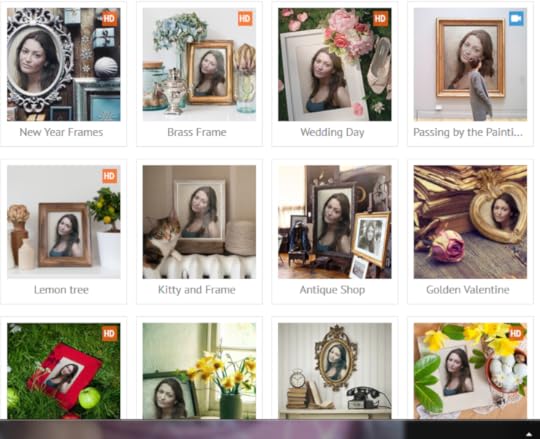
iArtView
iArtView is an app created expressly for artists looking to increase their sales by using high quality images of their art in personalized settings. Rather than preset wall images, you take a photo of the space where you want to see the art and the app auto-scales the work for you. You can try the app for free, but this is a paid app with monthly plans starting at $3.99. An increase in plan size gets you increased customization of the art and the space, an increased number of walls and images you can save, and analytics.
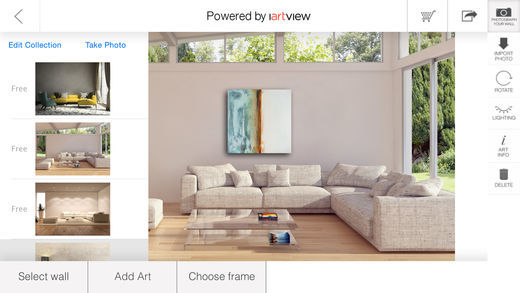
Shoot and Sell
Shoot and Sell is an app created for photographers as an in-person sales tool. Like iArtView, it allows you to take a photo of a custom space and add your image in-app. There is also a collection of stock rooms available. The app costs $74.99 which may give you a little sticker shock at first, but it’s a one-time fee versus a monthly fee like iArtView. However, if you want more stock rooms than the 11 the app comes with, you’ll have to pay.
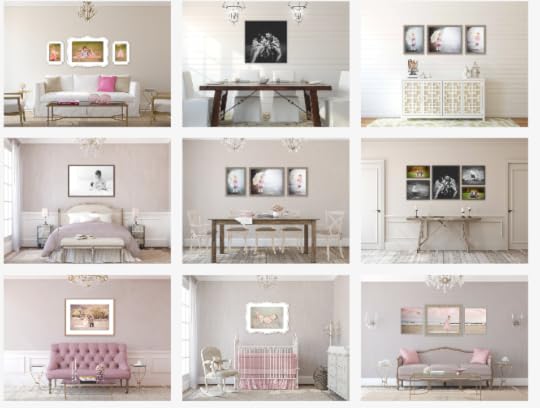
WallApp
Despite the name, WallApp is not a mobile app. It’s a simple webpage that allows you to either upload your own room photo or use a stock room photo and drag-and-drop images of your art. You can scale the artwork to different sizes in the space and download the resulting photo, although it does have “Made with the OhMyPrints Wall Art Tool” in the corner, so not the best choice for marketing materials. It can be used on mobile, but it isn’t optimized for mobile use so this isn’t the ideal tool if you want to do a lot of in-person selling.
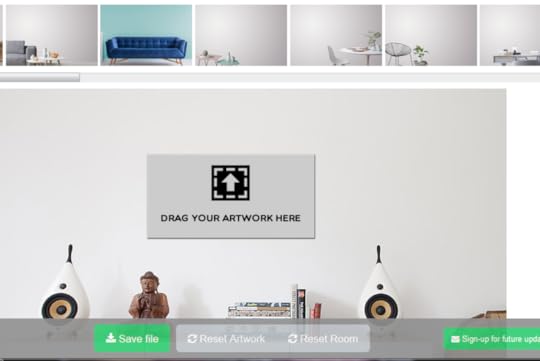
Mockup Scene Creator
Mockup Scene Creator by CreativeMarket has two versions- a Photoshop file download for $35 and an online editor for those without Photoshop. The online editor allows you to try it for free with limited functionality, or purchase one of several plans starting at $5 that provide various levels of e-commerce integration and image download credits.
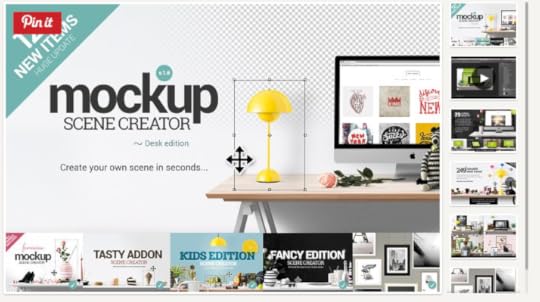
ArtSee
ArtSee is a free iOS-only app that allows you to take and resize a photo of your space and insert an image of your art. There are also a few stock images available. It’s a fairly simple app with limited customization, but if you don’t need the extra bells and whistles it’s a great free choice. ArtSee also registers galleries and allows potential collectors to see the artwork in their space and contact the gallery directly.

Walnut
Walnut is another free iOS app with a simple and limited range of features. Be forewarned that to find this app in the app store I had to search “Walnut Art”, the word walnut by itself does not bring it up. The website also appears to be defunct, but the app works fine. You can take a photo of any space you wish, add real-life measurements of the wall height, then add any photo of art you wish and line the two up to visualize. There are no customization options available, but it’s a quick, easy, and free solution that’s pretty user-friendly.
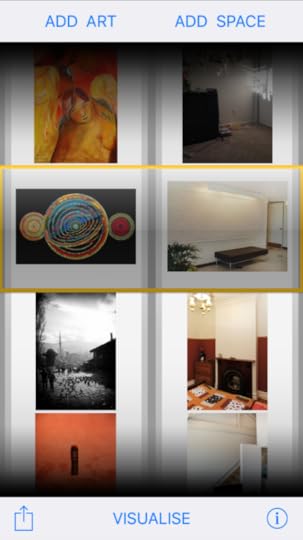
insitYou
insitYou is a free website (not an app) that allows you to visualize your artwork on a small variety of stock environments. There is an option to upload your own environment, but the upload option is greyed out and there doesn’t appear to be an upgrade option at this time (the website is in beta). There is a small range of customization options, including adding a frame and changing the color, adding a shadow behind the artwork, and changing the angle and perspective of the artwork. You can download your image without a watermark, and overall this is a great option for someone working on a desktop who doesn’t need the deeper customization of the paid options but still prefers a more professional look.
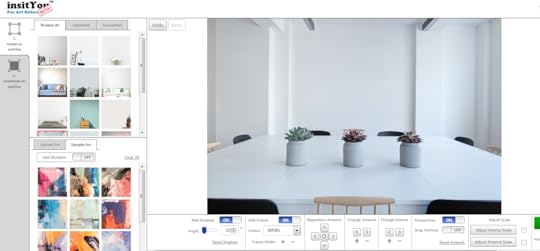
There’s a pretty good mix here of paid and free, simple and highly customizable. Are you using one of these and love it (or hate it)? Did we leave out a good one? Drop a comment below and let us know.
The post Top Apps for Previewing Your Art on a Wall appeared first on Online Marketing for Artists.
December 4, 2017
Being Part of the Art Conversation with Rex Hausmann
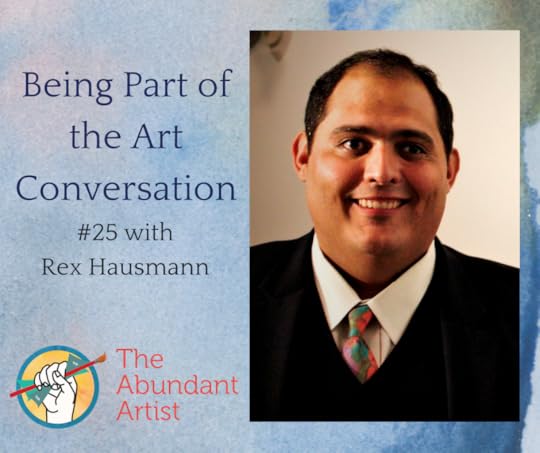
In this episode we cover:
1:40- Rex explains his philosophy of “grow where you’re planted”.
6:14- Rex talks about the Hausmann Millworks Creative Community
16:25- The kind of shows you should be trying to get into depends heavily on your age, where you are in your career, and which of many art worlds you’re a part of.
18:53- How artists should view and manage their upward career trajectory
23:50- Know the difference between the different art shows and art publications and don’t waste your energy submitting to shows that don’t represent your style
24:40- Rex talks about the different ways he sells his work, and the value of cultivating long-term relationships with collectors, curators, gallerists, etc.
28:11- What it looks like to be involved in the larger art conversation
33:17- Rex talks Francis Mallmann’s work as a kind of performance art
36:26- Why most of Rex’s work is autobiographical and his unique process of creating work
44:44- Alexander Calder and being a kid at heart
50:05- Good advice about living life and managing your art career
Download the transcript here:
Conversation with Rex Hausmann Transcript
Links:
Hausmann Millworks Creative Community
Top 9 Fine Art Shows in the Country
Alexander Calder’s Circus performance
The post Being Part of the Art Conversation with Rex Hausmann appeared first on Online Marketing for Artists.
November 29, 2017
7 Inspiring Artists on Instagram
More and more artists are finding that Instagram is THE place to be to cultivate a dedicated following and sell more art online. Whether you’ve been playing the Insta-game for a while or you’re new to the platform, you’ll find inspiration in this list of 7 artists who are killing it on Instagram. To explore more artists doing their thang on Instagram, check out this post.
@livingpattern: One glance at Jenny’s feed and it’s easy to see why she has so many followers- it’s a very beautiful and cohesive feed with bright photos and lots of white and green. She includes exclusive discount codes in many of her captions, which adds a little extra value to being a follower. She posts photos of her finished art, her work space, and her works in progress. All are very well lit. Her posts receive a lot of comments, and she responds to all of them.
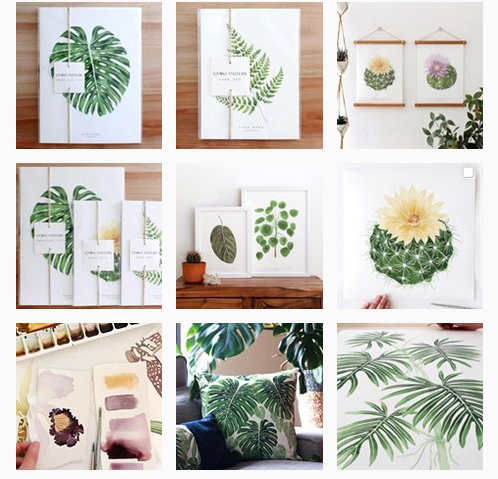
@amirarahimart: Amira Rahim’s feed is colorful, but consistently so. Amira posts many photos of works in progress, as well as charming pictures of her smiling face sprinkled in with inspirational quotes, shots of nature and things that inspire her, and photos of her work framed on people’s walls.
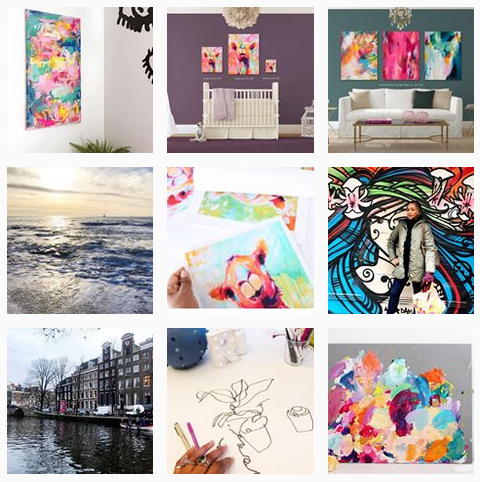
@piperpottery: Cammie Meerdink creates stoneware pottery with a heavy focus on leaves. She posts mesmerizing videos in which she slowly peels a real leaf away from a new piece of pottery to reveal the intricate leaf pattern left behind in the clay.
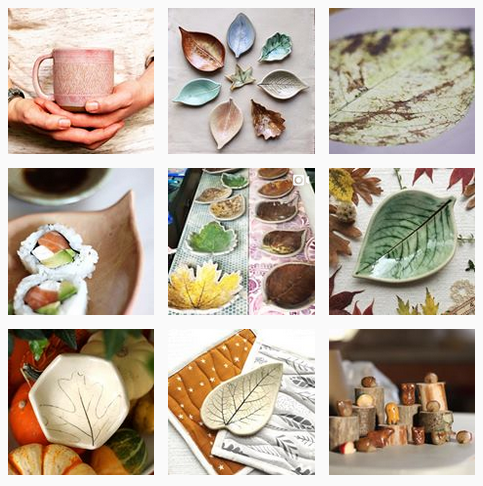
@christinejoypaintings: Although she has a lower number of followers than some of the other artists on this list, Christine’s posts have high engagement. She’s a plein air watercolorist and her posts are highly Instagrammable (is that a word?). It’s easy to understand the appeal:
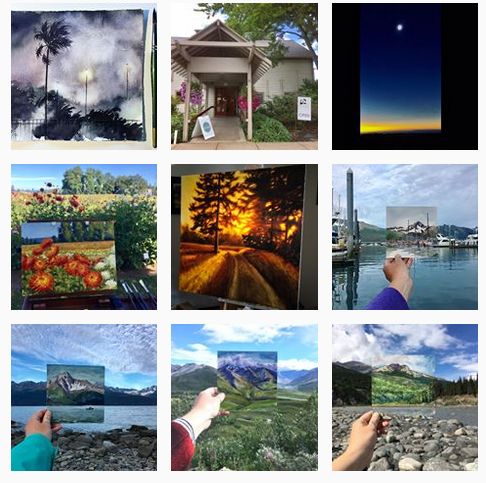
@thomas_shahan: Thomas Shahan is an illustrator and photographer specializing in macro shots… of spiders. Take a look even if you can’t stand spiders, because Shahan does the impossible and makes them look cute.
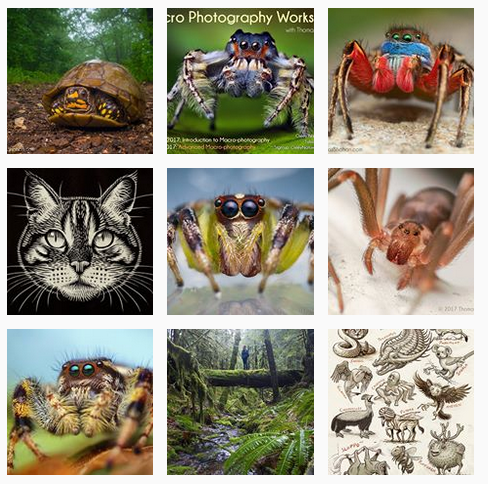
@kellycreates: Kelly Klapstein is a calligrapher who captivates her followers with her lettering videos. They’re simple, closeup, and hard to look away from, which earn each video over 100k views. She uses her videos to help sell her art and hand lettering courses and books.
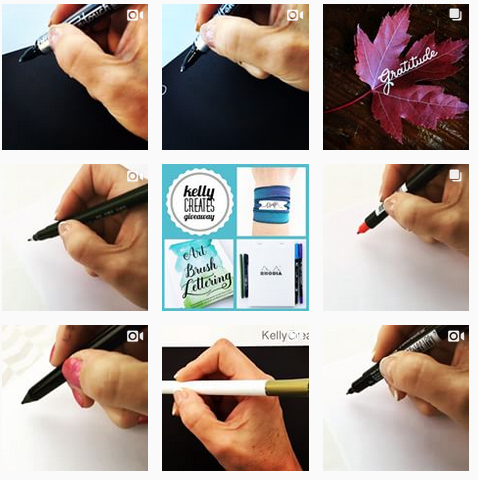
@spmlaw: Stephanie Law creates fantastical pieces with watercolor and gold leaf. Her feed is very consistent (not that occasional shots of your dog or selfies are wrong, but the cohesive look is professional and visually appealing.) She gives close-ups of her very complex pieces as well as timelapse videos of her works in progress. She uses her Instagram posts to share where and when the works in progress she’s sharing will be available for sale.
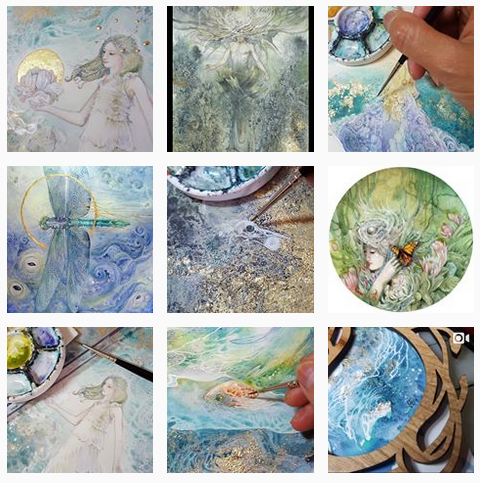
Not sure if Instagram is the right choice for you? Check out this comprehensive piece on how to choose the right social media selling platform. Do you know an artist who’s doing great stuff on Instagram (or maybe it’s you)? Share in the comments and spread the love. And of course don’t forget to follow @theabundantartist on Instagram too.
The post 7 Inspiring Artists on Instagram appeared first on Online Marketing for Artists.
The Abundant Artist Goodreads blog
- Cory Huff's profile
- 31 followers





